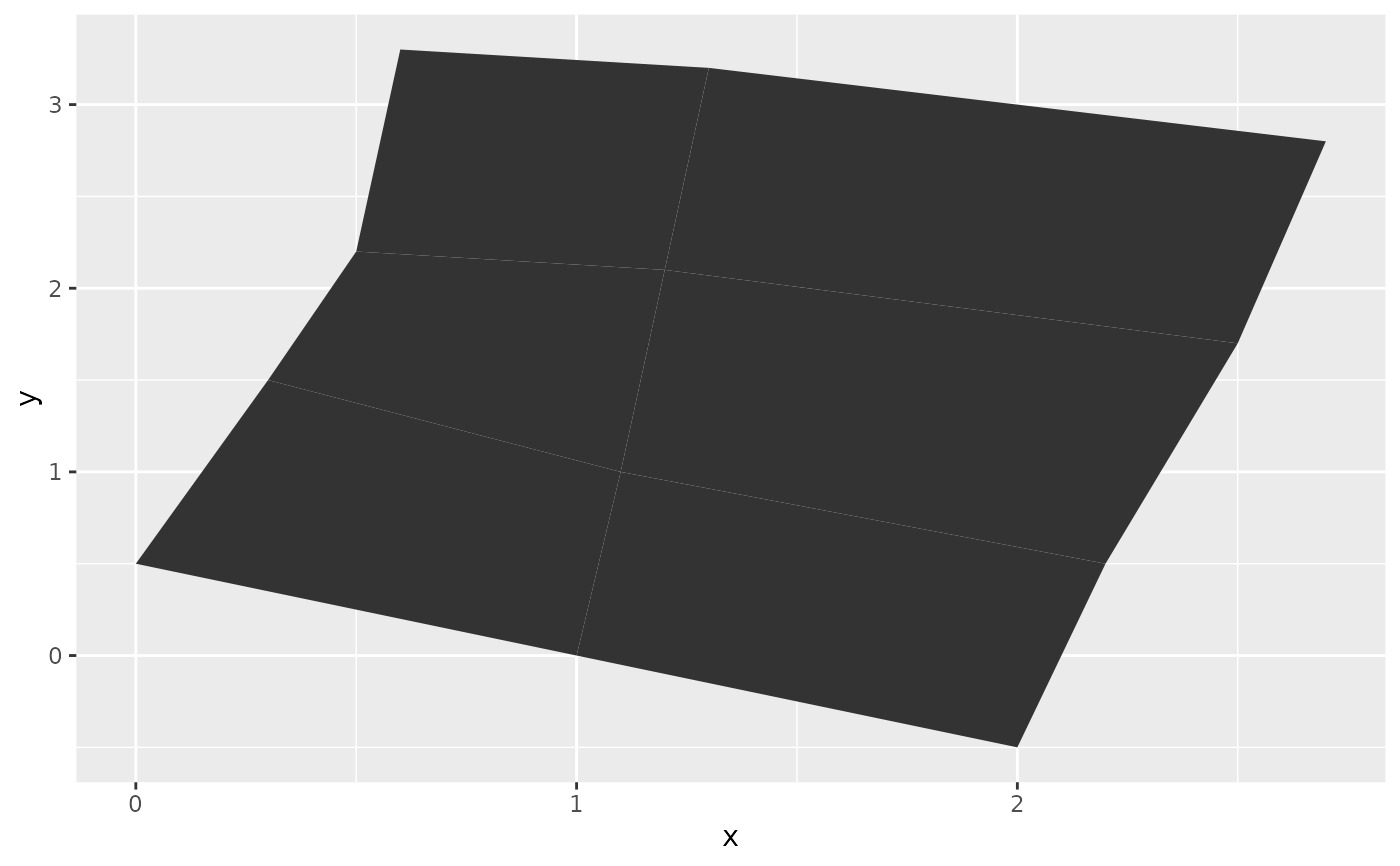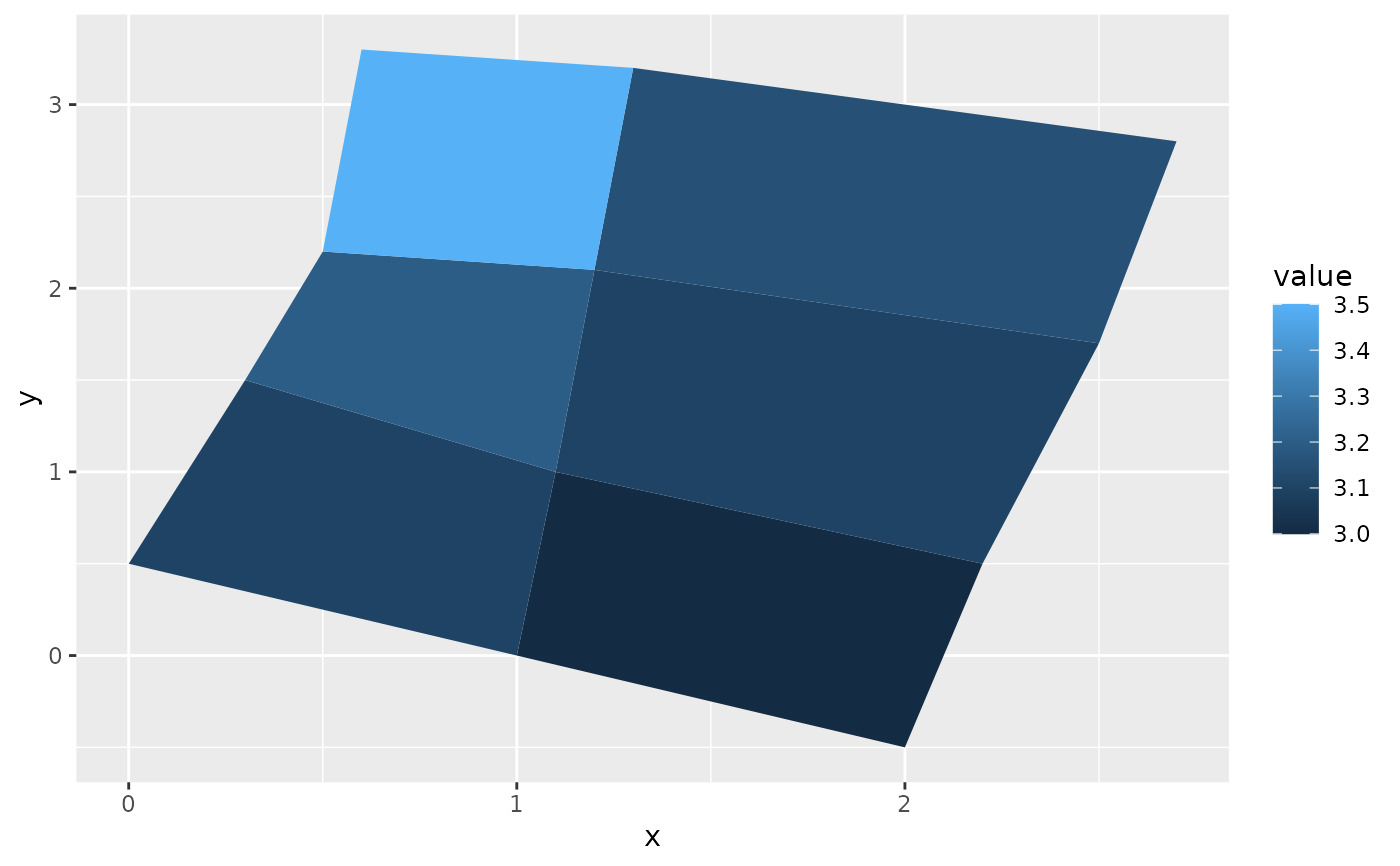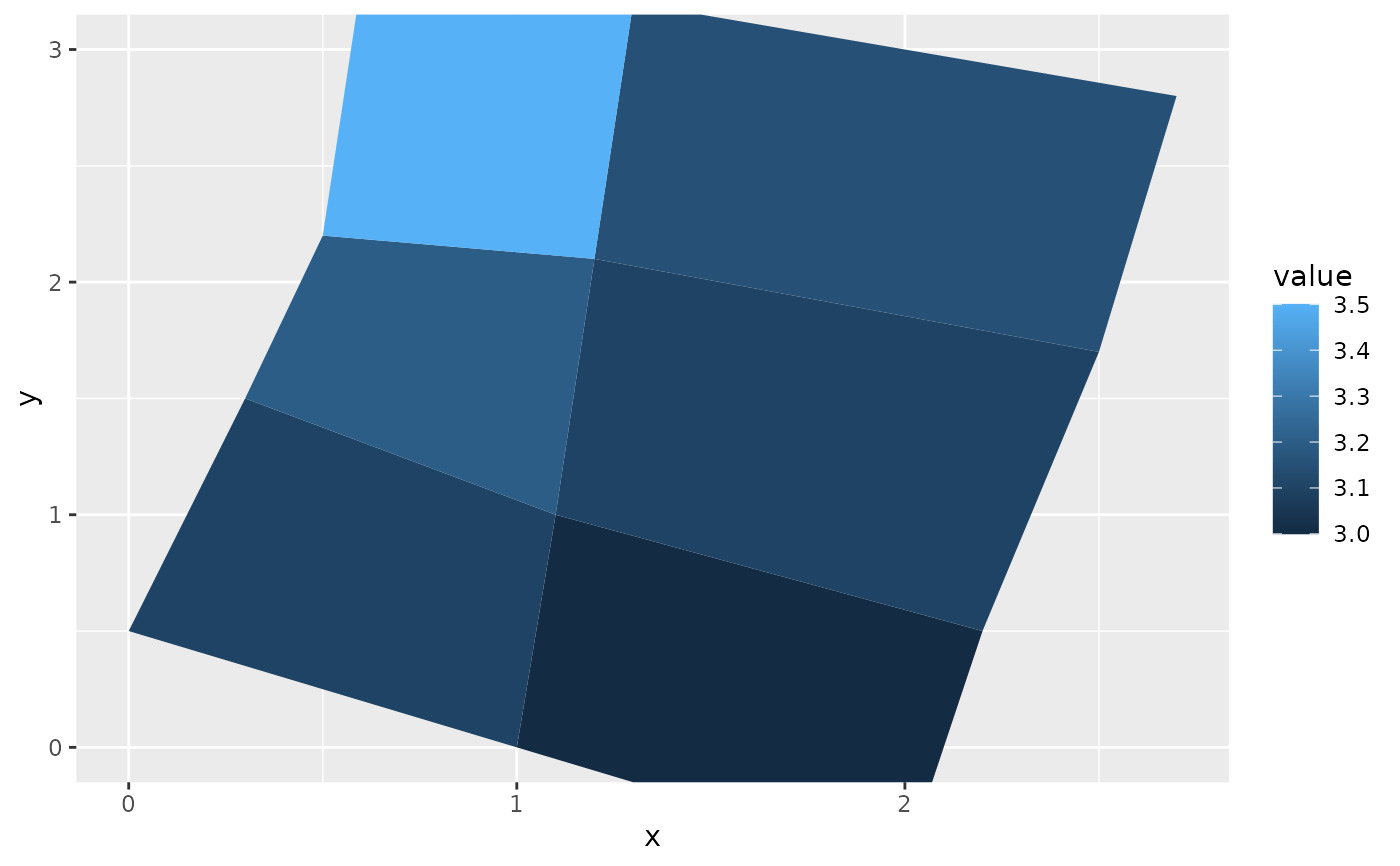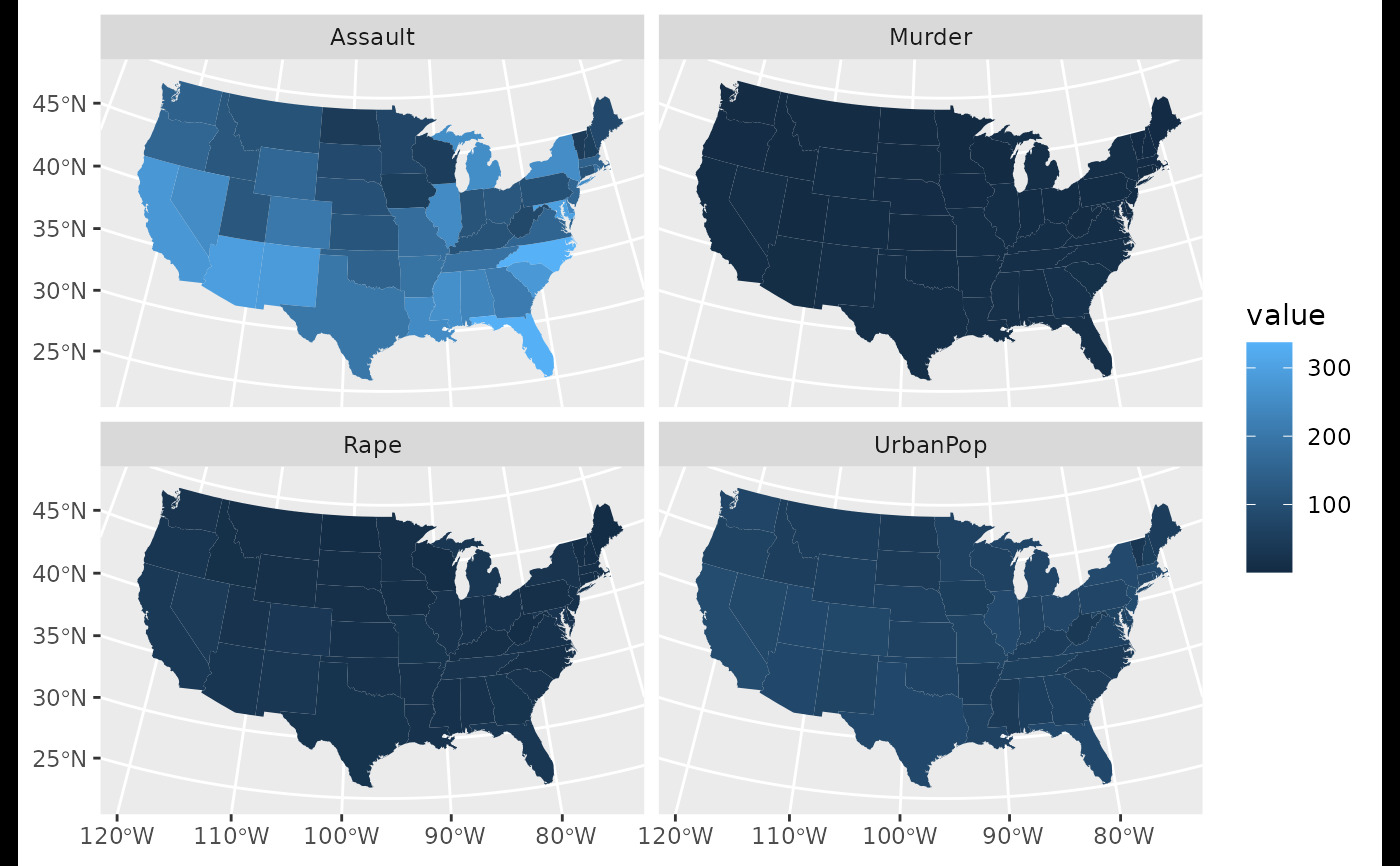將多邊形顯示為Map。這意味著注釋,因此它不會影響位置比例。請注意,此函數早於 geom_sf() 框架,並且不適用於 sf 幾何列作為輸入。但是,它可以與 geom_sf() 層和/或 coord_sf() 結合使用(請參閱示例)。
用法
geom_map(
mapping = NULL,
data = NULL,
stat = "identity",
...,
map,
na.rm = FALSE,
show.legend = NA,
inherit.aes = TRUE
)參數
- mapping
-
由
aes()創建的一組美學映射。如果指定且inherit.aes = TRUE(默認),它將與繪圖頂層的默認映射組合。如果沒有繪圖映射,則必須提供mapping。 - data
-
該層要顯示的數據。有以下三種選擇:
如果默認為
NULL,則數據繼承自ggplot()調用中指定的繪圖數據。data.frame或其他對象將覆蓋繪圖數據。所有對象都將被強化以生成 DataFrame 。請參閱fortify()將為其創建變量。將使用單個參數(繪圖數據)調用
function。返回值必須是data.frame,並將用作圖層數據。可以從formula創建function(例如~ head(.x, 10))。 - stat
-
用於該層數據的統計變換,可以作為
ggprotoGeom子類,也可以作為命名去掉stat_前綴的統計數據的字符串(例如"count"而不是"stat_count") - ...
-
其他參數傳遞給
layer()。這些通常是美學,用於將美學設置為固定值,例如colour = "red"或size = 3。它們也可能是配對的 geom/stat 的參數。 - map
-
包含Map坐標的 DataFrame 。這通常是在空間對象上使用
fortify()創建的。它必須包含列x或long、y或lat以及region或id。 - na.rm
-
如果
FALSE,則默認缺失值將被刪除並帶有警告。如果TRUE,缺失值將被靜默刪除。 - show.legend
-
合乎邏輯的。該層是否應該包含在圖例中?
NA(默認值)包括是否映射了任何美學。FALSE從不包含,而TRUE始終包含。它也可以是一個命名的邏輯向量,以精細地選擇要顯示的美學。 - inherit.aes
-
如果
FALSE,則覆蓋默認美學,而不是與它們組合。這對於定義數據和美觀的輔助函數最有用,並且不應繼承默認繪圖規範的行為,例如borders()。
美學
geom_map() 理解以下美學(所需的美學以粗體顯示):
-
map_id -
alpha -
colour -
fill -
group -
linetype -
linewidth -
subgroup
在 vignette("ggplot2-specs") 中了解有關設置這些美學的更多信息。
例子
# First, a made-up example containing a few polygons, to explain
# how `geom_map()` works. It requires two data frames:
# One contains the coordinates of each polygon (`positions`), and is
# provided via the `map` argument. The other contains the
# other the values associated with each polygon (`values`). An id
# variable links the two together.
ids <- factor(c("1.1", "2.1", "1.2", "2.2", "1.3", "2.3"))
values <- data.frame(
id = ids,
value = c(3, 3.1, 3.1, 3.2, 3.15, 3.5)
)
positions <- data.frame(
id = rep(ids, each = 4),
x = c(2, 1, 1.1, 2.2, 1, 0, 0.3, 1.1, 2.2, 1.1, 1.2, 2.5, 1.1, 0.3,
0.5, 1.2, 2.5, 1.2, 1.3, 2.7, 1.2, 0.5, 0.6, 1.3),
y = c(-0.5, 0, 1, 0.5, 0, 0.5, 1.5, 1, 0.5, 1, 2.1, 1.7, 1, 1.5,
2.2, 2.1, 1.7, 2.1, 3.2, 2.8, 2.1, 2.2, 3.3, 3.2)
)
ggplot(values) +
geom_map(aes(map_id = id), map = positions) +
expand_limits(positions)
 ggplot(values, aes(fill = value)) +
geom_map(aes(map_id = id), map = positions) +
expand_limits(positions)
ggplot(values, aes(fill = value)) +
geom_map(aes(map_id = id), map = positions) +
expand_limits(positions)
 ggplot(values, aes(fill = value)) +
geom_map(aes(map_id = id), map = positions) +
expand_limits(positions) + ylim(0, 3)
ggplot(values, aes(fill = value)) +
geom_map(aes(map_id = id), map = positions) +
expand_limits(positions) + ylim(0, 3)
 # Now some examples with real maps
if (require(maps)) {
crimes <- data.frame(state = tolower(rownames(USArrests)), USArrests)
# Equivalent to crimes %>% tidyr::pivot_longer(Murder:Rape)
vars <- lapply(names(crimes)[-1], function(j) {
data.frame(state = crimes$state, variable = j, value = crimes[[j]])
})
crimes_long <- do.call("rbind", vars)
states_map <- map_data("state")
# without geospatial coordinate system, the resulting plot
# looks weird
ggplot(crimes, aes(map_id = state)) +
geom_map(aes(fill = Murder), map = states_map) +
expand_limits(x = states_map$long, y = states_map$lat)
# in combination with `coord_sf()` we get an appropriate result
ggplot(crimes, aes(map_id = state)) +
geom_map(aes(fill = Murder), map = states_map) +
# crs = 5070 is a Conus Albers projection for North America,
# see: https://epsg.io/5070
# default_crs = 4326 tells coord_sf() that the input map data
# are in longitude-latitude format
coord_sf(
crs = 5070, default_crs = 4326,
xlim = c(-125, -70), ylim = c(25, 52)
)
ggplot(crimes_long, aes(map_id = state)) +
geom_map(aes(fill = value), map = states_map) +
coord_sf(
crs = 5070, default_crs = 4326,
xlim = c(-125, -70), ylim = c(25, 52)
) +
facet_wrap(~variable)
}
# Now some examples with real maps
if (require(maps)) {
crimes <- data.frame(state = tolower(rownames(USArrests)), USArrests)
# Equivalent to crimes %>% tidyr::pivot_longer(Murder:Rape)
vars <- lapply(names(crimes)[-1], function(j) {
data.frame(state = crimes$state, variable = j, value = crimes[[j]])
})
crimes_long <- do.call("rbind", vars)
states_map <- map_data("state")
# without geospatial coordinate system, the resulting plot
# looks weird
ggplot(crimes, aes(map_id = state)) +
geom_map(aes(fill = Murder), map = states_map) +
expand_limits(x = states_map$long, y = states_map$lat)
# in combination with `coord_sf()` we get an appropriate result
ggplot(crimes, aes(map_id = state)) +
geom_map(aes(fill = Murder), map = states_map) +
# crs = 5070 is a Conus Albers projection for North America,
# see: https://epsg.io/5070
# default_crs = 4326 tells coord_sf() that the input map data
# are in longitude-latitude format
coord_sf(
crs = 5070, default_crs = 4326,
xlim = c(-125, -70), ylim = c(25, 52)
)
ggplot(crimes_long, aes(map_id = state)) +
geom_map(aes(fill = value), map = states_map) +
coord_sf(
crs = 5070, default_crs = 4326,
xlim = c(-125, -70), ylim = c(25, 52)
) +
facet_wrap(~variable)
}

相關用法
- R ggplot2 geom_qq 分位數-分位數圖
- R ggplot2 geom_spoke 由位置、方向和距離參數化的線段
- R ggplot2 geom_quantile 分位數回歸
- R ggplot2 geom_text 文本
- R ggplot2 geom_ribbon 函數區和麵積圖
- R ggplot2 geom_boxplot 盒須圖(Tukey 風格)
- R ggplot2 geom_hex 二維箱計數的六邊形熱圖
- R ggplot2 geom_bar 條形圖
- R ggplot2 geom_bin_2d 二維 bin 計數熱圖
- R ggplot2 geom_jitter 抖動點
- R ggplot2 geom_point 積分
- R ggplot2 geom_linerange 垂直間隔:線、橫線和誤差線
- R ggplot2 geom_blank 什麽也不畫
- R ggplot2 geom_path 連接觀察結果
- R ggplot2 geom_violin 小提琴情節
- R ggplot2 geom_dotplot 點圖
- R ggplot2 geom_errorbarh 水平誤差線
- R ggplot2 geom_function 將函數繪製為連續曲線
- R ggplot2 geom_polygon 多邊形
- R ggplot2 geom_histogram 直方圖和頻數多邊形
- R ggplot2 geom_tile 矩形
- R ggplot2 geom_segment 線段和曲線
- R ggplot2 geom_density_2d 二維密度估計的等值線
- R ggplot2 geom_density 平滑密度估計
- R ggplot2 geom_abline 參考線:水平、垂直和對角線
注:本文由純淨天空篩選整理自Hadley Wickham等大神的英文原創作品 Polygons from a reference map。非經特殊聲明,原始代碼版權歸原作者所有,本譯文未經允許或授權,請勿轉載或複製。
